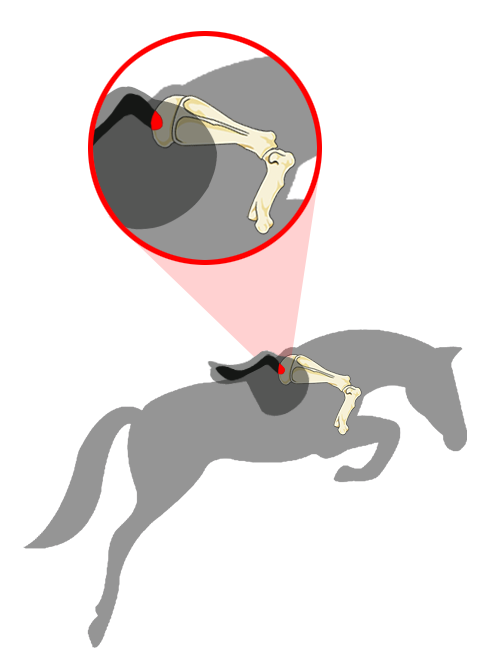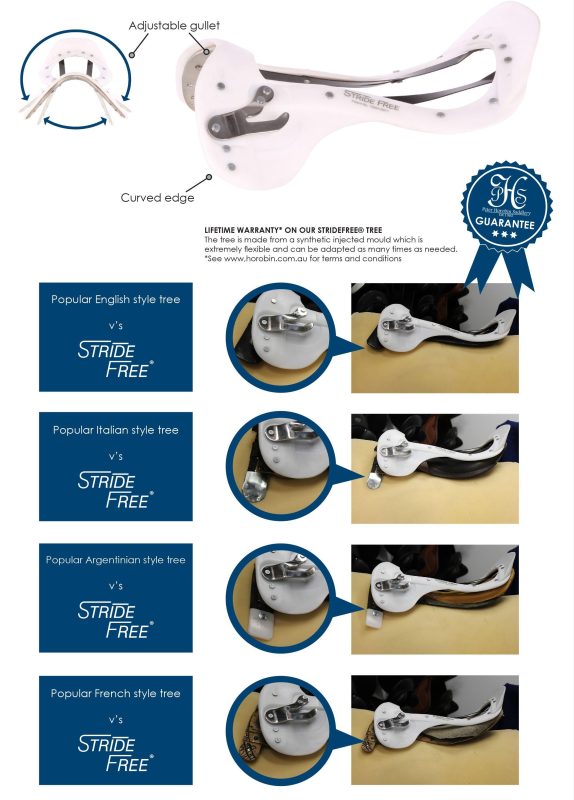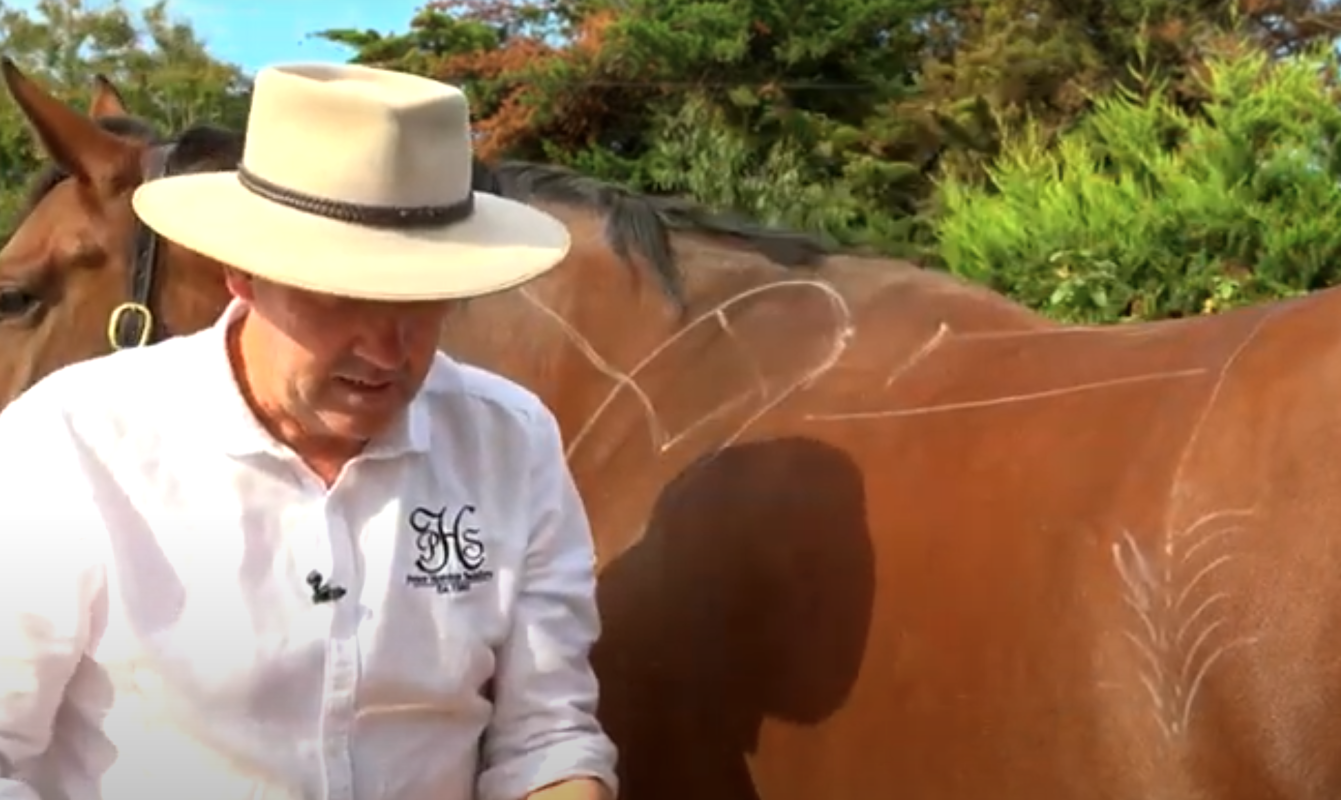The first completely biomechanically sound tree design!
The StrideFree® tree was created to give the horses’ shoulders maximum range of motion. This will enable a longer stride and results in a more relaxing and effective workout for the horse.
A ground-breaking redesign of the interface between you and the horse is the StrideFree tree.
Regular SADDLE

STrideFree® Saddle

Benefits in a nutshell!
The shorter, swooping back tree point and belled tree shape, which were designed to be anatomically correct, allow for complete movement of the scapula and spine.
Scientifically demonstrated to permit a longer stride! Top riders from all around the world concur that the StrideFree tree has enhanced horses’ comfort and performance.
- Complete mobility of the horses’ shoulder movement.
- Infinitely Adjustable. The StrideFree tree is continually and repeatedly adjustable thanks to the special composite material and design of the tree and gullet plate.
- The tree comes with a lifetime warranty!
- Wool flocked and flexible. Product that adapts to the shape and motions of the horses is natural, breathable, and sustainable.
- Panels for horses with short backs.
- Various options in girth positioning to suit various shapes.
- Every saddle fitter’s dream: on-site adjustability!
- StrideFree Saddles are crafted from premium skins that have been ethically tanned at recognized tanning facilities across Europe.
The creator himself explains!
Comparing the StrideFree® Tree?

Equilaterals EQUILATERALS StrideFree® gaint analysis!
It’s quite technical, but we can’t keep it from you!
Our UK agent, KM Elite, commissioned EquiLaterals’ Lucyanna Westaway to conduct a biomechanic case study on the horse’s gait and stride length when ridden in a StrideFree® saddle.
The following is a summary of the study’s findings:
Executive Synopsis
The research revealed that changing saddles resulted in significantly longer strides in both walk and trot. According to the investigation, the increased stride length resulted from opening up the movement of the shoulder and hips/stifle. There is also evidence of enhanced movement symmetry, however the results were not as consistent as those for stride length.
Biomechanic Gait Evaluation – Walk
Stride Characteristics
- As rode in a StrideFree® Saddle, the horse’s stride length at walk increased by 20% being compared to when ridden in another saddle.
- During the initial evaluation, the average degree of elevation remained consistent in both saddles.
- The horse had gained an average of 10% more elevation in the StrideFree® Saddle by the second assessment compared to the first assessment in the StrideFree® Saddle.
- Across all assessments, the speeds were consistent.
Limb Angles
- In the Other Saddle, the horse’s protraction and retraction along the right side in both the foreleg and hindleg were slightly reduced in comparison to the left side. The horse’s symmetry between the left and right sides was more tightly aligned in the StrideFree® saddle. (1st Evaluation)
- During the second evaluation, the horse was reluctant to walk and tended to jog. Because the graphs indicate this inconsistency in the walk movement, they are not deemed reliable for comparison purposes.
- When comparing the StrideFree® Saddle to the Other Saddle, the horse exhibits a greater wide angle (4°) throughout the action in both the left and right shoulder. (1st Evaluation)
- The foreleg fetlock and coronet angles in the Stride Free saddle are more symmetric between the left and right sides than in the Other Saddle. (1st Assessment)
- During the 1st Assessment, the hindleg angles in both saddles are extremely comparable.
Biomechanic Gait Assessment – Trot
Stride Characteristics
- When rode in a StrideFree® Saddle, the horse’s stride length at trot increased by 24% being compared to when ridden in another saddle.
- During the initial assessment, the horse showed a reduction in elevation (approx. 8%) when ridden in the StrideFree® saddle against the Other Saddle.
- By the second evaluation, the horse had developed an average of 6% more elevation in the StrideFree® Saddle than in the StrideFree® Saddle during the first evaluation.
- The speeds were constant across all evaluations.
Limb Angles
- As ridden in the StrideFree® Saddle, the horse exhibits 3° greater foreleg retraction on both the left and right side when compared to the Other Saddle. (1st Assessment)
- The protraction of the left foreleg remained about the same, while the right side increased by around 3° to demonstrate more symmetry of movement. (1st Assessment)
- The StrideFree® Saddle increased left hindleg protraction by 3° as compared to the Other Saddle. (1st Assessment)
- In the StrideFree® saddle, the shoulders move considerably more smoothly, particularly the right shoulder, which was a little inconsistent in its movement in the Other Saddle. Throughout the movement pattern, the average left shoulder angle opened by 4°. (1st Evaluation)
- During the second assessment, the hindlegs showed much improved symmetry in the StrideFree® Saddle.
- The right shoulder has opened up slightly by the second assessment in the StrideFree® Saddle, demonstrating a greater average angle throughout the action when compared to when ridden in the other saddle and to both saddles in the First Assessment.
- In both saddles, the elbow has a wider range of movement during the Second Assessment than during the First Assessment. This happens with the knee as well.
- When rode in the StrideFree® Saddle, the foreleg fetlock and coronet angles are more symmetrical than when ridden in the Other Saddle during both Assessments.
- In both saddles, the hips and stifle move more freely in the Second Assessment.
- During the Second Assessment, the hocks show a larger range of mobility (5°) in both saddles.
- The hindleg fetlock and coronet angles show more aligned symmetry in the First Assessment





